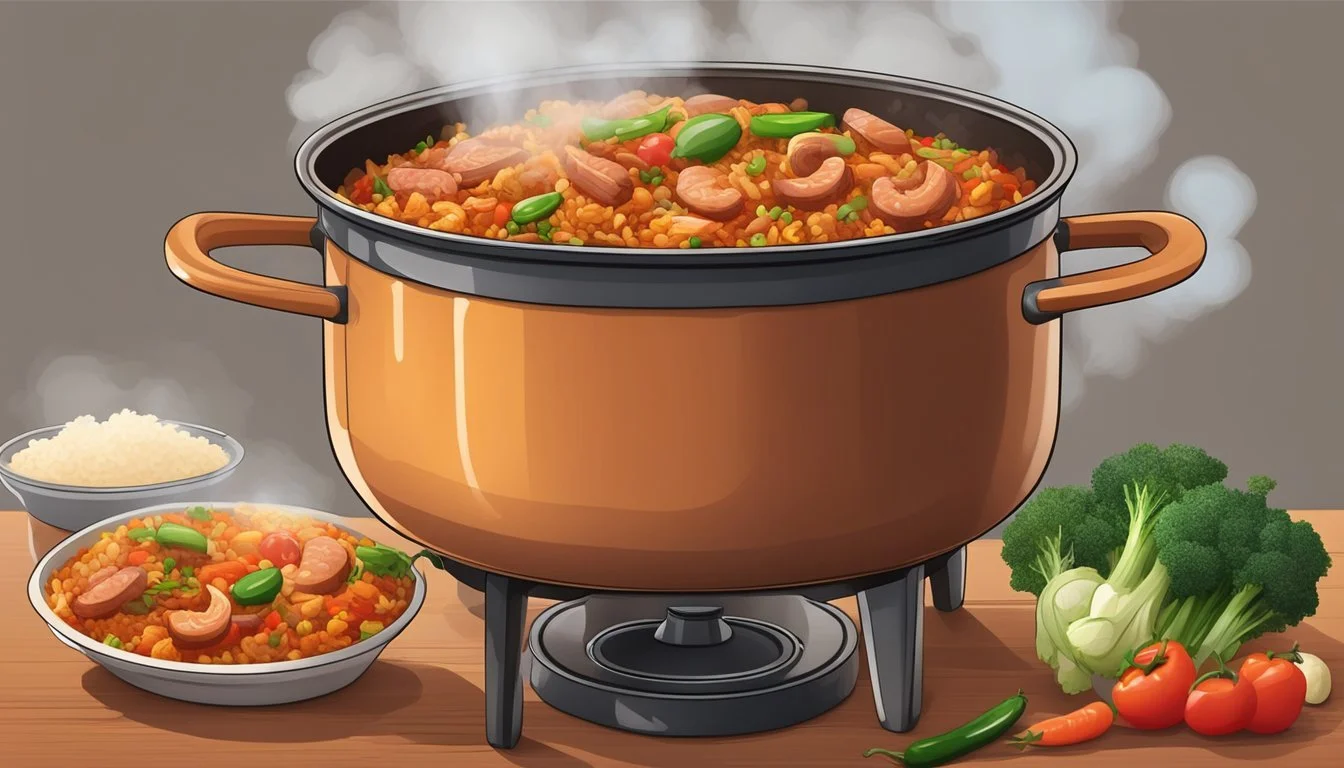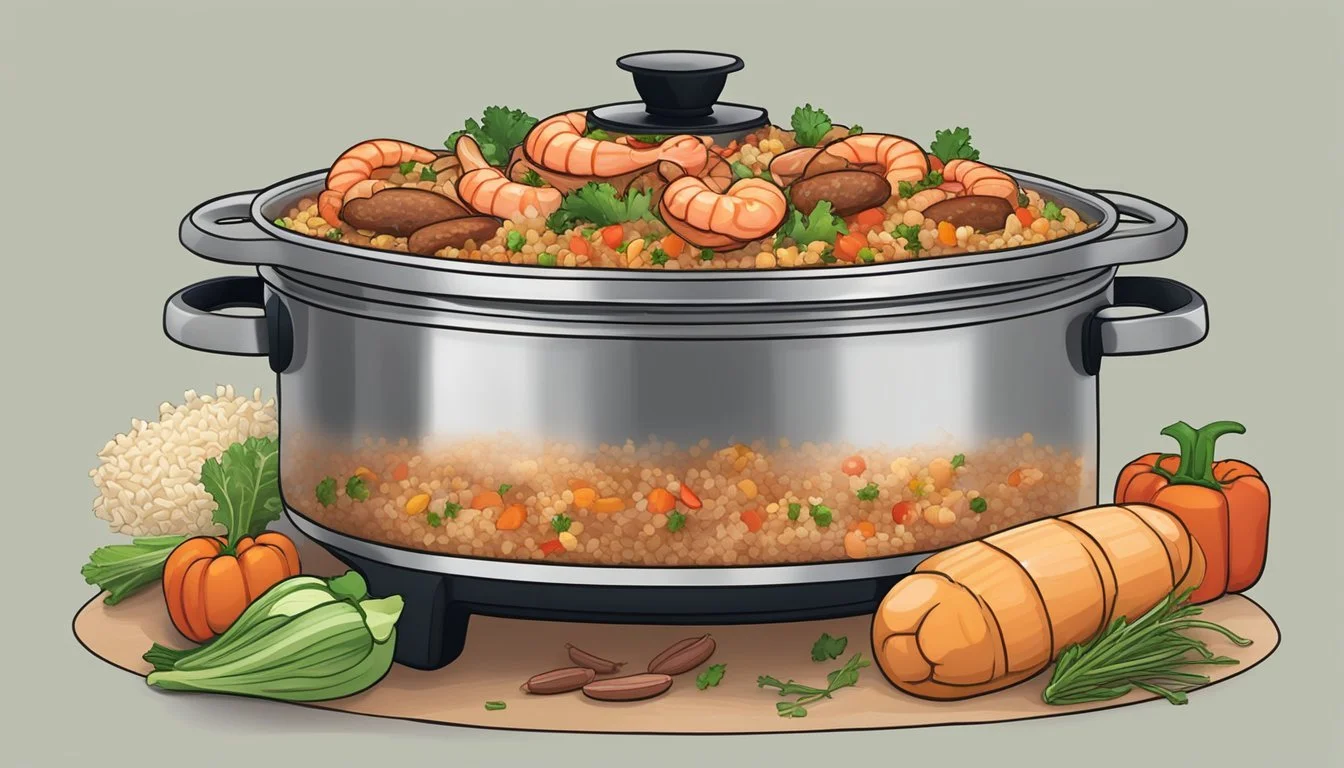Best Way to Reheat Creole Jambalaya
Ensuring Perfect Texture and Spiciness
Jambalaya, a Creole and Cajun staple hailing from Louisiana, is a vibrant dish known for its bold flavors and heartwarming concoction of rice, vegetables, and a mix of proteins such as chicken, sausage, and seafood. Its complexity doesn't end with the cooking process, as the challenge often extends to reheating leftovers without compromising the dish’s texture and spiciness. Achieving this requires a delicate balance of heat and moisture to ensure that the rice does not dry out and the myriad of spices remains as tantalizing as when the dish was first prepared.
Reheating Creole jambalaya is both an art and a science, with specific methods to preserve the quality of this Louisiana classic. It's essential to gently warm the dish to maintain its moisture and avoid turning the rice into a mushy texture. The objective is to replicate the fresh consistency and robust flavors of the original serving, allowing the distinctive seasoning to come through without being dulled down by the reheating process. Each technique, from the oven to stovetop to microwave, offers a different path to reviving leftover jambalaya, but all aim to retain the essence that makes this Creole dish an enduring favorite.
Understanding Jambalaya
Jambalaya is a hallmark of Creole and Cajun cuisine, often recognized as a flavorful, one-pot rice dish with a blend of cultural influences and robust seasonings. It marries a variety of ingredients to create a dish that's both hearty and versatile.
Origins and Types
Creole Jambalaya: Originating from the French Quarter of New Orleans, Creole jambalaya, also known as "red jambalaya," includes tomatoes which give it a distinctive color and flavor. The Creole version is a reflection of the region's multicultural makeup, primarily the Spanish and French heritage intertwined with African and Native American influences.
Cajun Jambalaya: Native to the rural areas of Louisiana, Cajun jambalaya omits tomatoes and typically has a smokier taste. This variety is born from the French Acadian immigrants adapting their traditional cooking methods, like those used in making French paella, to local ingredients.
Key Ingredients
Main Ingredients Seasonings and Spices Rice Garlic Chicken Thyme Sausage Cayenne Pepper Shrimp Paprika Ham Bay Leaves
In addition, Creole and Cajun jambalayas often include a mix of vegetables like bell peppers, onions, and celery, known as the "holy trinity" of both cuisines. The proportion of meats and shrimp may vary according to personal preference, contributing to the dish's hearty character.
Typical Cooking Methods
Traditionally, jambalaya is a one-pot meal cooked on the stovetop. The proteins—chicken, sausage, shrimp, and ham—are sautéed with vegetables and seasoning, then simmered with rice and stock until everything is tender and flavorful. The low-and-slow cooking approach allows each ingredient to impart its flavor, resulting in a complex and satisfying dish.
In addition to stovetop cooking, jambalaya can also be prepared in a slow cooker, ensuring that the rice absorbs the full spectrum of flavors while maintaining its distinct texture. Whichever method used, maintaining the right balance of moisture and heat is crucial to prevent the rice from becoming too dry or mushy.
Storing Leftover Jambalaya
Proper storage of leftover jambalaya is essential for maintaining its quality and preventing foodborne illnesses. The two main methods for storing jambalaya involve refrigeration and freezing, each suitable for different durations of storage.
Refrigerating Leftovers
To refrigerate leftover jambalaya, it must be cooled to room temperature within two hours to prevent the growth of Bacillus cereus, a bacteria known to cause food poisoning. Once cooled, the jambalaya should be placed in a sealed container and stored in the fridge. Here are specific steps to ensure food safety:
Cool Down: Allow the jambalaya to come to room temperature within two hours of cooking.
Transfer: Place the leftover jambalaya in a shallow airtight container to expedite cooling.
Seal: Seal the container tightly to prevent contamination and moisture loss.
Refrigerate: Store in the refrigerator at or below 40°F (4°C).
Leftover jambalaya can last in the fridge for 3 to 4 days.
Freezing Jambalaya
For long-term storage, freezing jambalaya is the best option. Freezing leftover jambalaya can extend its shelf life up to six months, provided it's done correctly:
Cooling: Ensure leftovers reach room temperature before freezing.
Portioning: Divide the jambalaya into individual portions to make it easier to thaw only what's needed.
Wrapping: Use aluminum foil or freezer wrap to cover the jambalaya, followed by a layer of plastic wrap for added protection against freezer burn.
Container: Transfer the wrapped portions into a freezer-safe container or zip-top freezer bag.
Labeling: Label the container with the date of freezing to keep track of storage time.
When needed, thaw the jambalaya in the refrigerator overnight to retain texture and prevent the growth of harmful bacteria. Once thawed, consume the jambalaya promptly to ensure safety and quality.
Reheating Jambalaya
Reheating Jambalaya properly is essential to preserving its rich textures and flavors. Key methods include using a microwave, oven, or stovetop, each requiring specific steps to ensure food safety and maintain the dish's quality.
Microwave Reheating
To reheat jambalaya in the microwave, place the jambalaya in a microwave-safe dish and sprinkle a tablespoon of broth or water over it to maintain moisture. Cover the dish with a microwave-safe lid or plastic wrap, venting slightly to allow steam to escape.
Step 1: Add moisture with broth or water.
Step 2: Cover with a vented lid.
Step 3: Microwave on medium power, checking and stirring every 30 seconds.
This method is quick but may unevenly heat the jambalaya, so it's crucial to stir regularly and check for even warmth.
Oven Method
Using an oven to reheat jambalaya involves a slow, uniform heating method that helps to prevent the rice from drying out while maintaining its texture.
Preheat the oven to 350°F (177°C).
Place jambalaya in an oven-safe dish.
Add 2-3 tablespoons of broth or water to the dish.
Cover the dish with foil to lock in moisture.
Temperature: 350°F (177°C)
Time: Warm the jambalaya for 15-25 minutes.
Food Safety: Ensure the internal temperature reaches 165°F (74°C).
Stovetop Techniques
For those who prefer to reheat jambalaya on the stove, doing so in a frying pan can help retain the dish's texture and spices.
Heat the pan over medium-low heat.
Transfer jambalaya to the pan and add a little broth or water.
Stir the jambalaya frequently to distribute heat and prevent sticking.
Key Points:
Heat: Medium-low to maintain texture.
Moisture: A tablespoon or two of broth or water prevents dryness.
Duration: Reheat until thoroughly warmed, usually within 5-10 minutes.
Remember, food safety is a priority; jambalaya must be reheated to an internal temperature of 165°F (74°C) before serving.
Maintaining Texture and Flavor
Properly reheating Creole jambalaya is crucial for preserving its distinctive texture and spiciness. The key lies in temperature control and the strategic inclusion of moisture.
Proper Temperature Control
To avoid overcooking the meat and turning the rice in the jambalaya into mush, one should reheat the dish at moderate temperatures. An oven set to 350°F (177°C) proves effective. This allows the jambalaya to warm evenly without compromising the integrity of its Creole flavors.
Oven: Preheat to 350°F and heat in a covered oven-safe dish for about 15-25 minutes.
Stovetop: Warm over medium heat, stirring occasionally to prevent burning.
Microwave: Use a lower power setting and short intervals, stirring in between rounds.
Recommended food safety guidelines suggest that one should always check the dish's internal temperature with a food thermometer to ensure it has reached 165°F (74°C).
Adding Moisture When Reheating
The addition of a small amount of broth or water during the reheating process helps to maintain the jambalaya's moisture, which is essential to its overall flavor and texture.
Add 2-3 tablespoons of chicken or vegetable broth, or water, to keep the jambalaya from drying out.
Incorporate ingredients like hot sauce or freshly chopped herbs after reheating to rejuvenate the dish's flavors.
Artful reheating under these guidelines not only preserves the integrity of the Creole dish but also ensures that it remains a vibrant medley of spices and textures, reminiscent of when it was first prepared.
Serving Suggestions and Conclusions
When reheating jambalaya leftovers, the objective is to preserve the dish's rich flavors and textures while also considering ways to complement the main course. Thoughtful accompaniments and final touches can elevate the reheated jambalaya to a meal that is almost as fresh and vibrant as when it was first cooked.
Accompaniments
Side Salad: A simple side salad with a light vinaigrette helps to cut through the richness of jambalaya and refreshes the palate.
Crusty Bread: Warm, crusty bread serves as the perfect vehicle for sopping up any flavorful juices left on the plate.
Tortillas/Tacos: For a creative twist, jambalaya can be served with warm tortillas, allowing diners to make their own jambalaya tacos.
Final Touches
Seasonings: A small pinch of seasonings can be added after reheating to enhance the spice profile of the jambalaya.
Hot sauce: A dash of hot sauce may be offered for those who prefer an extra kick.
Freshly Chopped Herbs: Garnishing with freshly chopped herbs, such as parsley or cilantro, brings a burst of color and freshness to the dish.





